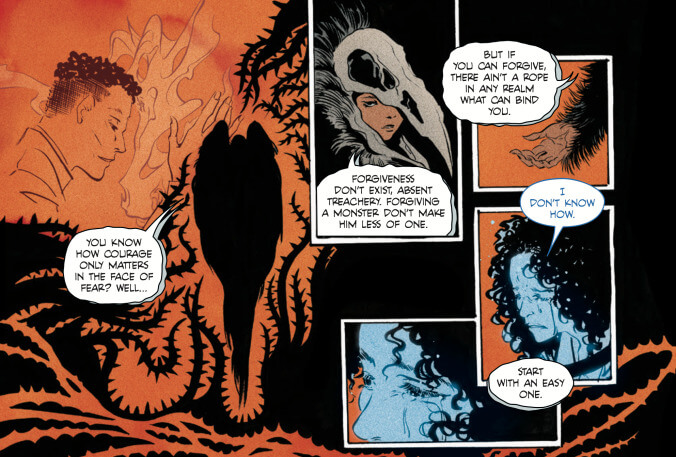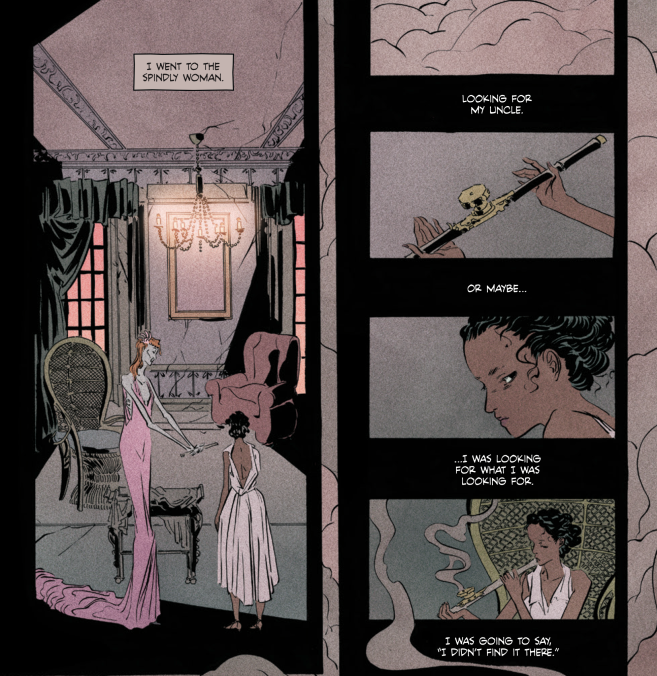Pretty Deadly: The Rat battles obsession in Golden Age Hollywood

Every artist feels the pull of obsession. The act of creation requires a certain level of preoccupation with the art, allowing it to take over the mind in order to craft a song or a painting or a story. If the artist finds widespread success, that obsession can shift from the art to the fame, the need for attention outweighing the need to create. In the early days of Hollywood, the movie industry brought both art and fame obsessives to California, people who were passionate about exploring a burgeoning new medium and looking to gain worldwide acclaim in the process. But there were also plenty of predators waiting to take advantage of that passion, luring in dreamers and exploiting their talent with unfulfilled promises.
Hollywood is the treacherous setting of Pretty Deadly: The Rat, the latest leg of writer Kelly Sue DeConnick, artist Emma Ríos, colorist Jordie Bellaire, and letterer Clayton Cowles’ surreal, poetic journey through genre. They tackled Westerns in the first arc, war stories in the second, and just concluded a noir-infused mystery addressing the rot that continues to permeate an entertainment industry that views people as disposable commodities. One of the best comics of last year, Pretty Deadly: The Rat continues the thrilling evolution of a creative team that is always innovating, with DeConnick providing her collaborators with a story that gives them ample room to experiment.
Clara Fields came to Hollywood with an incredible skill for shadow puppetry. She met a director who gave her an audience, but as a young black woman in a heavily segregated industry, Clara was never going to receive the accolades she deserved. Pretty Deadly: The Rat begins as an investigation into Clara’s apparent suicide by her uncle, who joins forces with Ginny, Death’s daughter, and the Reaper Of Vengeance to uncover why Clara threw herself from the top of the Hollywood sign. They confront Clara’s deceitful director and the Reaper Of Thirst that fed Clara’s opium habit, and while both played a part in Clara’s demise, they weren’t the force that drove her over the edge. That blame rests on the Reaper Of Obsession, who used Clara as bait to lure out its true target: Sissy, the young girl who currently holds the mantle of Death.
Venturing into the realm of Obsession brings a major change in Pretty Deadly’s storytelling, moving away from crime noir for a spectacular battle unfolding on a spiritual plane. Last month’s issue featured some of Ríos and Bellaire’s most dynamic work yet as Ginny futilely faced off against Obsession, trying to cut away at a foe that can’t be pinned down. Emma Ríos is a comic-book trailblazer, and the greatest joy of Pretty Deadly is seeing what ambitious new leap she will make from issue to issue. The Rat features breathtaking images of old Hollywood glamour, but the defining characteristic of Ríos’ art for this series is the use of silhouettes, with Clara’s shadow-puppet work dictating how her story unfolds. The Reaper Of Obsession doesn’t have a concrete form, it exists in an ever-shifting shadow state, first appearing as a dragon before turning into a visual cacophony of thorns, teeth, and tendrils.
After four issues of learning about Clara through other people, Pretty Deadly: The Rat #5 reveals her perspective of events as she wanders through limbo, denied entry into Death’s garden. It’s a portrait of a tortured artist who finds herself in over her head in an industry that doesn’t care for her humanity, leaving her vulnerable to the Obsession’s pull, which sends her up to the top of the Hollywood sign and down to her death. When Clara recounts her time with the director, Ríos presents these moments as pictures on a film strip. She uses the same general layout when the action shifts to the Reaper Of Thirst, but she removes the small cutout squares to remove the film-strip illusion, now evoking a ladder that leads Carla into Obsession’s grasp.
The depiction of Obsession is one of the coolest things about Pretty Deadly: The Rat, highlighting the fluidity and intense graphic impact of Ríos and Bellaire’s artwork. When Carla gets her first glimpse at Obsession, it appears as a serpentine pale red mass that looks like flowing lava shooting lightning bolts. As symbols of metamorphosis, butterflies are one of the key visual motifs of Pretty Deadly, and Obsession takes the shape of a huge swarm of butterflies that guide Clara to the Hollywood sign. Ríos builds up to Clara’s fateful fall with a fascinating page design, eliminating individuals panels to show all the action within the outline of the flitting throng of butterflies. It’s a brilliant way of visually reflecting Obsession’s spell over Clara, heightening tension with visual chaos before resolving it with a full-page shot of Clara following the insects right over the edge of the giant H.
Obsession still has a hold on Clara in Death, now feeding on the resentment she feels toward the people who wronged her in life. The only way for her to break free is through forgiveness, and Clara’s story ends with a poignant message about removing the shackles of victimhood. “Forgiving a monster don’t make him less of one,” Sissy tells Clara. “But if you can forgive, there ain’t a rope in any realm what can bind you.” Forgiveness isn’t about absolving others of the sins they commit against you, but giving yourself the power to not let their actions define your life. Instead of obsessing over grievances, you allow yourself to move on and find new strength to push forward.
The backmatter of Pretty Deadly has always significantly enriched the main story, and The Rat features insightful interviews with the creative team along with essays that highlight the book’s historical roots and different approaches to visual storytelling and genre. Rachel R. Miller’s essays provide valuable context about the real-world figures that inspired Clara: Lotte Reiniger, whose work with shadow puppets and invention of the multiplane camera would shape modern animation, and Peg Entwistle, the actress who jumped off the Hollywoodland sign, as it was then known, and became an essential part of the town’s mythology.
Writer Samantha Cross examines how Pretty Deadly’s three arcs have embraced a variety of storytelling styles, from cantastoria—the art of singing a song while gesturing at images—to Chinese handscrolls and shadow plays, and in this final issue, Cross examines how Pretty Deadly subverts genre expectations across its three arcs. There’s an immense amount of care that goes into this series, which is why it’s easy to forgive the three-year gap between storylines. Art of this caliber takes time, and whenever Pretty Deadly returns next, readers can expect an emotional story that pushes visual boundaries as it dives into a new genre landscape.
